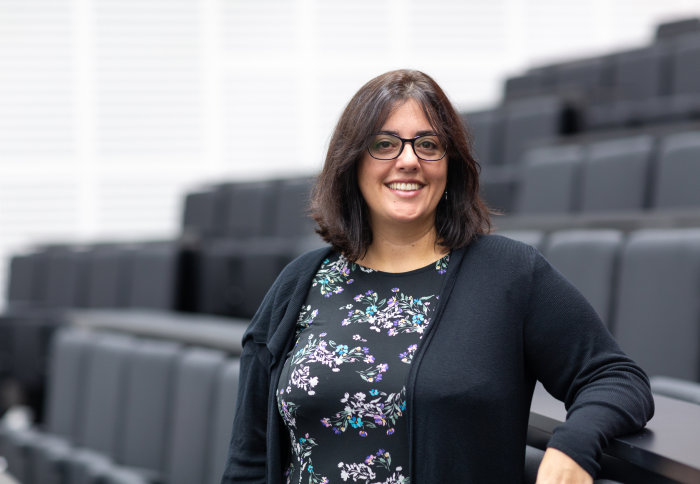Bringing electricity and chemistry together with a £1.6M project

Dr Clotilde Cucinotta is trying to solve the combined electrical and chemical problem, paving the way for next-generation energy sources.
Dr Cucinotta joined Imperial this year, bringing an EPSRC grant of more than £1.6 million and a wide range of experience. We talked to her about her research, her journey so far, and why the Molecular Sciences Research Hub – the new home for Chemistry at Imperial’s White City campus – is the best place to carry out her plans.
What will you use the grant to study?
In essence, I study electrochemical problems. We have been able to study electrical and chemical processes separately – such as electron transport or chemical reactions in materials – but not the two together.
All of this now feels like part of a plan – all those bits of knowledge are all components of my new research focus: the electrochemical problem. Dr Clotilde Cucinotta
My research aims to bring the two together so that we have more complete picture of what happens in materials, for example when sunlight strikes solar panels or when batteries are charged.
Current progress in many of these areas has stalled because we don’t really know how these coupled chemical and electrical processes happen. We can characterise them at an atomic scale, but we don't have a comprehensive theory to explain the phenomena. Without theory, we cannot predict what will happen when we make new materials – so all of our work is based on trial and error.
With the right theory, and the right models arising from that theory, we can simulate true electrochemical reactions for the first time in a realistic way. Understanding these reactions will help us design optimised devices.
What are the applications of the research?
Although based in theory and modelling, my work has a wide landscape of practical applications, particularly in energy research. For example, the process of splitting water into hydrogen and oxygen, a crucial step in photosynthesis, can be realised with an electrochemical reaction. If we can understand it, and improve it, we can build efficient artificial leaves for harvesting sunlight to produce hydrogen, the fuel of the future.

It could also help with many other energy devices, such as fuel cells, batteries and supercapacitors, and photovoltaics such as solar panels.
Besides energy, there are electrochemical reactions everywhere – including in our bodies. The flow of electrical impulses between nerve cells, for example, is initiated by potential differences.
Sensor technologies also often rely on measuring electrical currents that are affected by local chemicals. Modelling the movement of the current and the transformations in the atomic configuration of chemicals is essential to understanding how these processes operate.
Your work is very multidisciplinary – how do you handle all the different strands?
My profile is very multidisciplinary – I started off in physics, studying condensed matter, before investigating the chemistry of surfaces, particularly grafting of organic molecules on semiconductor surfaces.
At ETH Zurich I pioneered methods for simulating the dynamics and chemistry of materials and molecular systems, and looked at more depth at chemical reactions, such as the reactions that underlie fuel cell functioning and hydrogen storage. This is where my interest in energy began, which is now at the heart of my research.
The problem of modelling electron transport processes, for example in transistors was then my focus. I also looked at new classes of materials, such as 2D materials, which are considered very promising materials for a range of applications, including nanoelectronics and water splitting.
All of this now feels like part of a plan – all those bits of knowledge are all components of my new research focus: the electrochemical problem, which combines electron transport and chemical transformation simulations.
What attracted you to Imperial?
Imperial is inherently multidisciplinary so it’s a natural place to do this kind of work. I can discuss and collaborate with experimentalists who are all next door. There are inspiring principles, especially in the new Molecular Sciences Research Hub, where people with different expertise work together in order to solve problems in new ways.

I have been at Imperial only around six months now, but I have already been able to get involved with many of the cross-disciplinary groups and activities, at the Grantham Institute, the Energy Futures Lab, the Institute for Molecular Science and Engineering, the London Centre for Nanotechnology and the Thomas Young Centre for the Theory and Simulation of Materials.
I’m thrilled by the opportunity of build a network of researchers across faculties and departments to work on the electrochemical problem, and to create a community that can work together to develop new science, host seminars, exchanges, and be a place for young students to excel.
There are also lots of potential collaborations with industry that I want to explore at Imperial. We share the same problems and I am looking forward to sharing the new methods and tools we create in a way that is easy for non-experts to use, allowing simpler modelling of experiments in action.
Article supporters
Article text (excluding photos or graphics) © Imperial College London.
Photos and graphics subject to third party copyright used with permission or © Imperial College London.
Reporter
Hayley Dunning
Communications Division